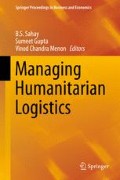Abstract
Disasters have been striking mankind quite regularly from time immemorial. The way mankind responded to these disasters has changed from just fleeing from the location to modern-day ability to stay put and face the scenario of aftereffects of the disaster. This change in perception and requirement is the result of a sea change in sociopolitical factors as well as advancement in science and technology to cater for the exigencies of a disaster. However, the more the ability to stay back and fight the disaster, the better need be the agility and flexibility to convey the benefits of research and technology to the location where it is needed most at the quickest possible time. This is possible only if there is a robust supply chain (SC) designed to cater for all eventualities. This paper is an attempt to identify the configurations of the SC for disaster management and thus analyze humanitarian logistic issues and try to suggest a model for incorporating humanitarian logistics into SC models.
Access this chapter
Tax calculation will be finalised at checkout
Purchases are for personal use only
References
Alexander DE (1993) Natural disasters. UCL Press, London
Beamon B (2004) Humanitarian relief chains: issues and challenges. In Proceedings of the 34th international conference on computers and industrial engineering, San Francisco
Centre for Research on the Epidemiology of Disasters (2004) Thirty years of natural disasters 1974–2003: the numbers. UCL Press, Brussels. http://www.emdat.be/Documents/Publications/publication_2004_emdat.pdf. Accessed 15 Jan 2009
Dash SR, Mishra US, Mishra P (2013) Emerging issues and opportunities in disaster response SC management. Int. J Sup. Chain. Mgt 2(1):55–61. March 2013
Douglas P, Gail K, Michel D (2005) Exploring the Complexity of social and ecological resilience to hazards. In: Paton D, Johnston D (eds) Disaster resilience: an integrated approach. Charles C. Thomas Publisher, Springfield, Ill, USA, pp 190–212
Drabek TE, McEntire DA (2003) Emergent phenomena and the sociology of disaster: lessons, trends, and opportunities from the research literature. Disaster Prev Manag 12(2):97–112
Ergun O, Karakus G, Keskinocak P, Swann J, Villarreal M (2011) Operations research to improve disaster supply chain management. H. Milton Stewart School of Industrial and Systems Engineering, Georgia Institute of Technology, Atlanta
Fischer HW (2002) Terrorism and 11 September 2001: does the ‘behavioral response to disaster’ model fit? Disaster Prev Manag 17(2):123–7
Hale T, Moberg CR (2005) Improving supply chain disaster preparedness: A decision process for secure site location. Int J Phys Distrib Logist Manag 35(3):195–207
Helferich OK, Cook RL (2002) Securing the SC: management report. CLM Publications, Oak Brook
Iakovou E, Douligeris C (2001) An information management system for the emergency management of hurricane disasters. Int J Risk Assess Manag 2(3/4):243–62
Lester W, Krejci D (2007) Business ‘not’ as usual: the national incident management system, federalism, and leadership. Public Adm Rev 67(1):84–93. December 2007
McHugh CP (1995) Preparing public safety organizations for disaster response: a study of Tucson, Arizona’s response to flooding. Disaster Prev Manag 4(5):25–36
Warwick M (1995) Painful lessons in crisis mismanagement. Commun Int 22(2):4–5
White House (2006) The federal response to Hurricane Katrina, Lessons Learned Washington. http://www.whitehouse.gov/reports/katrina-lessonslearned.pdf
Whybark DC, Melnyk SA, Day J, Davis ED (2010) Disaster relief supply chain management: new realities, management challenges, emerging opportunities. Decis Line, pp 4–7. http://ejournal.narotama.ac.id/files/Disaster%20relief%20supply%20chain%20management.pdf
Witt JL (1997) Creating the disaster-resistant community. Am City County 112(1):23–31
Yokohama strategy and plan of action for a safer world-guidelines for natural disaster prevention, preparedness and mitigation (1994) World Conference on Natural Disaster Reduction Yokohama, Japan. http://www.ndmindia.nic.in/Mitigation/mitigationhome.html
Author information
Authors and Affiliations
Editor information
Editors and Affiliations
Rights and permissions
Copyright information
© 2016 Springer India
About this chapter
Cite this chapter
Raghukumar, B.R., Agarwal, A., Sharma, M.K. (2016). An Agile and Flexible Supply Chain for Efficient Humanitarian Logistics in a Disaster Management System. In: Sahay, B., Gupta, S., Menon, V. (eds) Managing Humanitarian Logistics. Springer Proceedings in Business and Economics. Springer, New Delhi. https://doi.org/10.1007/978-81-322-2416-7_9
Download citation
DOI: https://doi.org/10.1007/978-81-322-2416-7_9
Publisher Name: Springer, New Delhi
Print ISBN: 978-81-322-2415-0
Online ISBN: 978-81-322-2416-7
eBook Packages: Business and ManagementBusiness and Management (R0)

